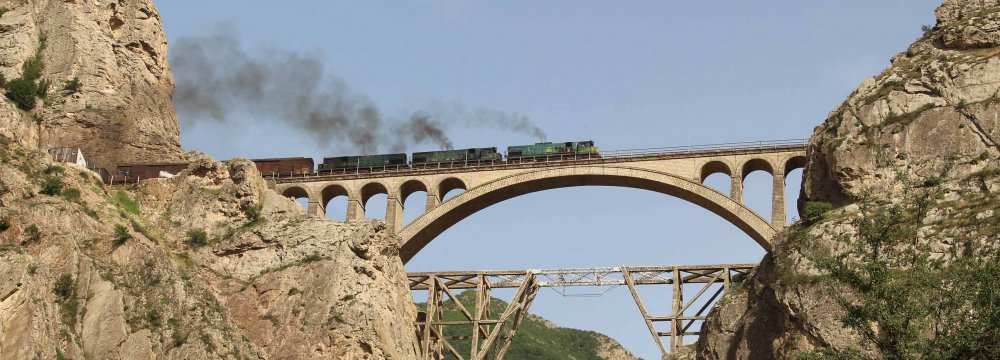Trans-Iranian Railway Inscribed on UNESCO’s World Heritage List

Economy July 26, 2021 18:31 0 Trans-Iranian Railway Inscribed on UNESCO’s World Heritage List . . . . . The World Heritage Committee has inscribed Trans-Iranian Railway on UNESCO’s World Heritage List.The decision was taken during the committee’s 44th session held online and chaired from Fuzhou (China) on Sunday, UNESCO wrote on its website.Other inscriptions
Economy July 26, 2021 18:31 0 Trans-Iranian Railway Inscribed on UNESCO’s World Heritage List  . . . . .
. . . . .
The World Heritage Committee has inscribed Trans-Iranian Railway on UNESCO’s World Heritage List.
The decision was taken during the committee’s 44th session held online and chaired from Fuzhou (China) on Sunday, UNESCO wrote on its website.
Other inscriptions decided at the session included Quanzhou: Emporium of the World in Song-Yuan China (China), Kakatiya Rudreshwara (Ramappa) Temple, Telangana (India), and Paseo del Prado and Buen Retiro, a landscape of Arts and Sciences (Spain).
The Trans-Iranian Railway connects the Caspian Sea in the northeast with the Persian Gulf in the southwest crossing two mountain ranges as well as rivers, highlands, forests and plains, and four different climatic areas.
Started in 1927 and completed in 1938, the 1,394-kilometer railroad was designed and executed in a successful collaboration between the Iranian government and 43 construction contractors from many countries.
The railroad is notable for its scale and the engineering works it required to overcome steep routes and other difficulties.
Its construction involved extensive mountain cutting in some areas, while the rugged terrain in others dictated the construction of 174 large bridges, 186 small bridges and 224 tunnels, including 11 spiral tunnels.
Unlike most early rail projects, the construction of the Trans-Iranian Railway was funded by national taxes to avoid foreign investment and control.
Veresk Bridge: An Engineering Masterpiece
In 1933, the Danish Consortium Kampsax, which had been chosen by the government of Iran as general contractor for the Trans-Iranian Railway, assigned Lot number 8 on the Northern section of the project to the Italian Engineer Guido Romeo Pizzagalli from Milan.
In November 1933, he founded the company Impresa G.R. Pizzagalli & C. together with several Italian engineers, including the three brothers Battista, Guido and Cesare Delleani from Biella.
The lot had a total length of 7,600 meters with a height difference of 186 meters and was composed of 10 tunnels, and two major bridges, one with a length of 52 meters and an arch of 25 meters and the second with a length of 112 meters and an arch of 60 meters, which is now considered the masterpiece of Trans-Iranian Railway and which has been among the world’s tallest bridge at the time of construction.
Cesare Delleani was in charge of the construction of the bridge. The project had been overseen by a group of engineers of Kampsax.
Works on the bridge started in August 1934. The bridge and the whole lot was finished by December 1935 and handed over to the contractor by January 1936. Work on the lot has been carried out by 260 specialized workers from Europe, mostly from Italy and about 2,700 unspecialized workers from Asia. Two cable-ways had been installed for the transport of workers and building material to the bridge construction.
The bridge stands 110 meters above the valley, its arch measures 66 meters and the overall length of the bridge is 112.40 meters.
The Veresk bridge connects the railroad between Tehran and the Caspioan Sea region. It is located in Mazandaran’s Veresk district of Savadkuh County, 85 kilometers south of Qaemshahr and connects two of the mountains in the Abbasabad region. The bridge is one of the masterpieces of the Danish engineering firm Kampsax, (consisting of Danish, German and Austrian engineers like Ladislaus von Rabcewicz) as well as Italian civil construction sector serving the Trans-Iranian Railway network in northern Iran.
Unique Geographical Position
Iran’s geographical position offers potential corridor routings that could link the Persian Gulf and the Sea of Oman in its south with the landlocked Central Asian states, Russia, China and with Europe.
This is why China is channeling one of its six proposed China’s Belt and Road Initiative corridors, the so-called “China–Central Asia–West Asia Corridor”, through Iran. Chinese interests in Iran’s corridor development come along with visible investments into Iran’s rail infrastructure.
What adds to Iran’s importance for China’s BRI-corridors is the fact that capacity limits have been reached at several cross-border bottlenecks on the northern routes of BRI, according to German magazine Railway Technical Review (Eisenbahntechnische Rundschau).
The INSTC, the second emerging transport artery crossing Iran, is the second focal point of Iranian rail investments. The planned multimodal corridor is envisaged to connect Mumbai via shipping to Iran’s ports in Chabahar and Bandar Abbas. The northern part of the corridor will link Iran via Azerbaijan to Moscow.
With the opening of the cross-border bridge from Astara (Azerbaijan) to Astara (Iran) in 2017, INSTC gained new momentum.
. . . . https://financialtribune.com/node/109594Click to copy the urlCopied . Republishing Guidelinessorce
برچسب ها :
ناموجود- نظرات ارسال شده توسط شما، پس از تایید توسط مدیران سایت منتشر خواهد شد.
- نظراتی که حاوی تهمت یا افترا باشد منتشر نخواهد شد.
- نظراتی که به غیر از زبان فارسی یا غیر مرتبط با خبر باشد منتشر نخواهد شد.
شما باید وارد شوید تا نظر بنویسید.

ارسال نظر شما
مجموع نظرات : 0 در انتظار بررسی : 0 انتشار یافته : 0